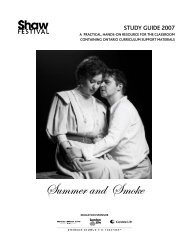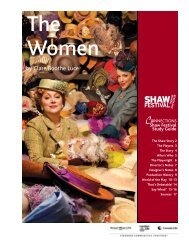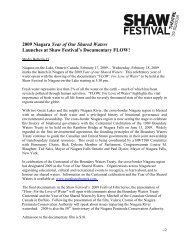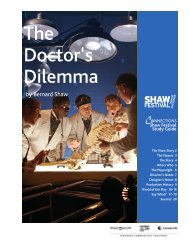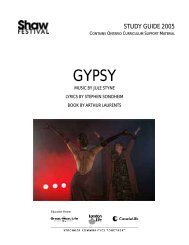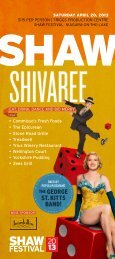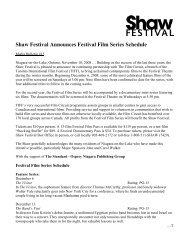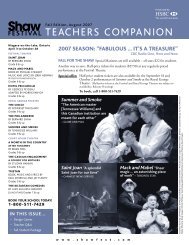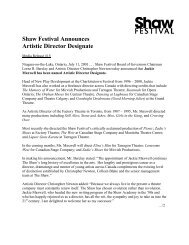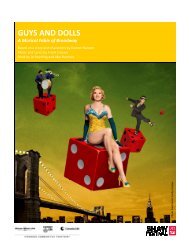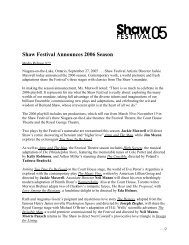Ragtime - Shaw Festival Theatre
Ragtime - Shaw Festival Theatre
Ragtime - Shaw Festival Theatre
You also want an ePaper? Increase the reach of your titles
YUMPU automatically turns print PDFs into web optimized ePapers that Google loves.
THE WORLD OF THE PLAY cont’d<br />
CLASS WARFARE<br />
Throughout 1900, workers demand better working conditions and higher pay, resulting in labour<br />
disputes. Uniting workers proves to be an enormous challenge because the workers are divided along<br />
racial and ethnic lines.<br />
Working conditions are, in many cases, intolerable; pay is inadequate; life in the tenements is<br />
unbearable; violence and poverty run rampant. As a result, workers begin to organize and strike;<br />
demanding that business pay attention to the health and safety of workers.<br />
RACIAL DISCRIMINATION<br />
After the Civil war (1865), African Americans voted, sent representatives to Congress, and served as<br />
sheriffs and justices of the peace. By 1900 all of that comes to an end. In the South, segregation and<br />
“Jim Crow” regulations restrict civil rights and prevent African Americans from voting. Hostility<br />
toward people of colour, religious minorities and immigrants grows along with organizations such as<br />
the Ku Klux Klan. Klan members resort to lynching and other acts of terrorism. The last remaining<br />
African American congressman, George White, introduces a bill to make lynching a federal crime, but<br />
the motion is defeated. In his farewell speech, White challenges colleagues about the injustice African<br />
Americans suffer. It is the last speech that any black man gives to Congress for the next 28 years!<br />
Booker T. Washington, author of the well-known autobiography Up From Slavery, creates the<br />
Tuskegee Institute in 1881, dedicated to teaching African Americans practical, marketable skills.<br />
Washington urges his followers to create businesses and to become self-reliant people. He mentors a<br />
new African American leader, W.E.B. Du Bois. Du Bois believes that without political power African<br />
Americans will never achieve equality and aims to fight injustice with scholarship and reason. By<br />
1899 he is a professor at Atlanta University. However, he witnesses a vicious crime—the lynching of<br />
African American Sam Hose— and this changes his mind about fighting bigotry through reason and<br />
writing, causing a split between himself and his mentor, Washington.<br />
In <strong>Ragtime</strong>, the struggle against racial discrimination is told through the story of Coalhouse Walker<br />
Junior, who is horribly abused and bullied by members of the Emerald Isle firehouse. Police repeatedly<br />
ignore his petition for help and, as a result, Coalhouse takes matters into his own hands.<br />
ACTIVITIES<br />
Post-Show<br />
ASK: Why do you think the men from the firehouse destroyed Coalhouse’s car?<br />
Have students collect examples of how different ethnic groups are portrayed in today’s media from<br />
newspapers, magazines or from commercials and sitcoms. What messages do these images send?<br />
Have students select an image of an ethnic or racial minority from contemporary culture and write a<br />
personal essay about what the image conveys—positive or negative. Were any images hard to find?<br />
What would students like to see depicted? Was it different than what they found?<br />
How do modern images of African Americans in popular culture compare to the images from America<br />
in 1900? Has there been an improvement in this depiction? Why or why not?<br />
17<br />
C ONNECTIONS<br />
<strong>Shaw</strong> <strong>Festival</strong> Study Guide



